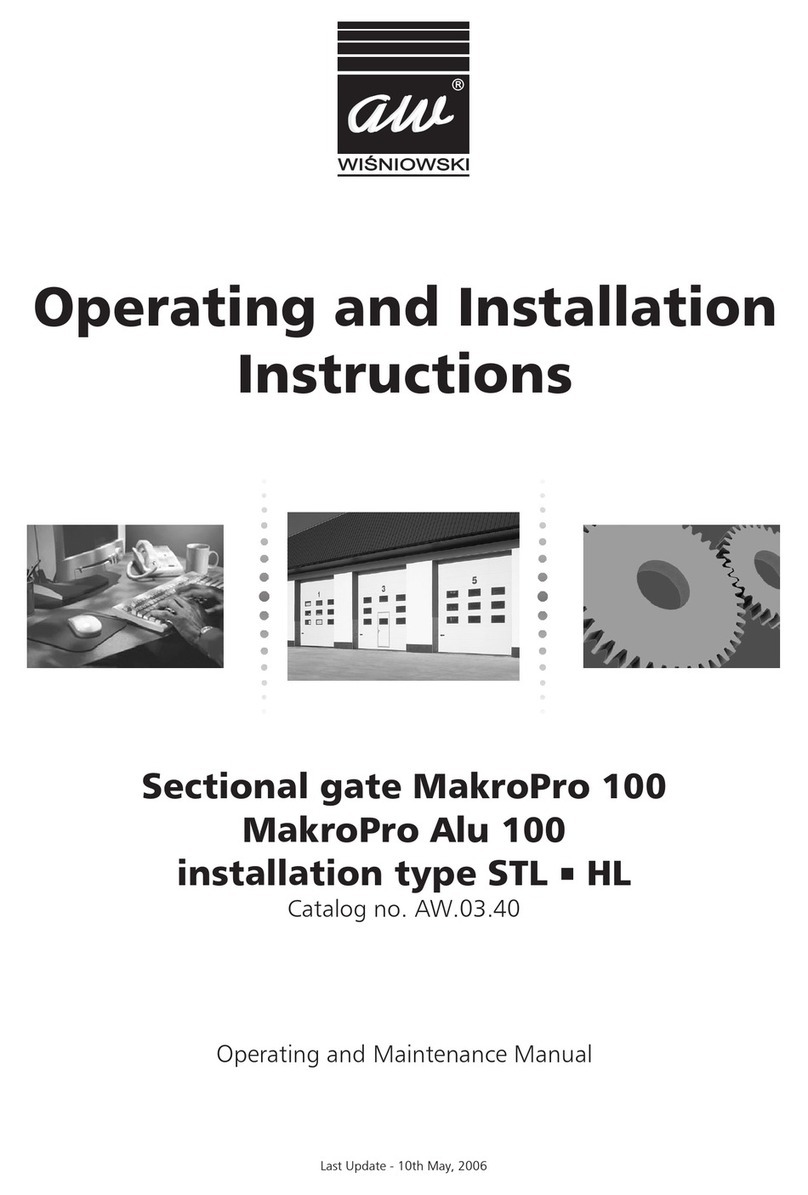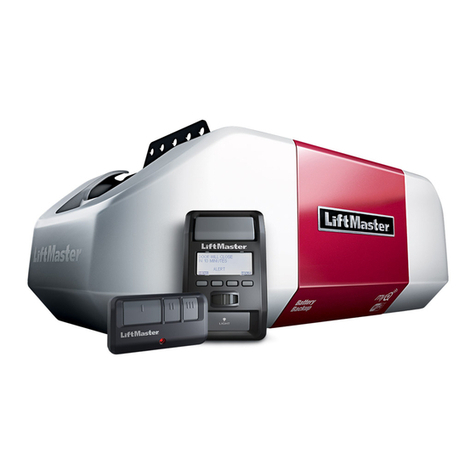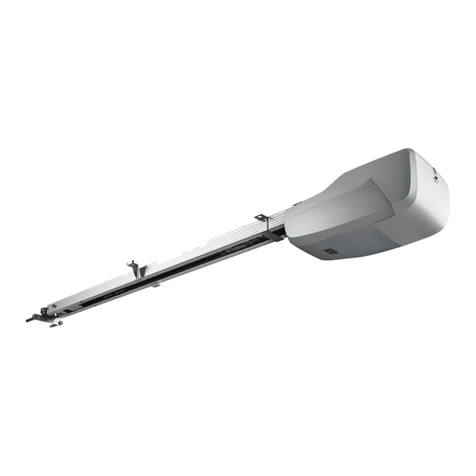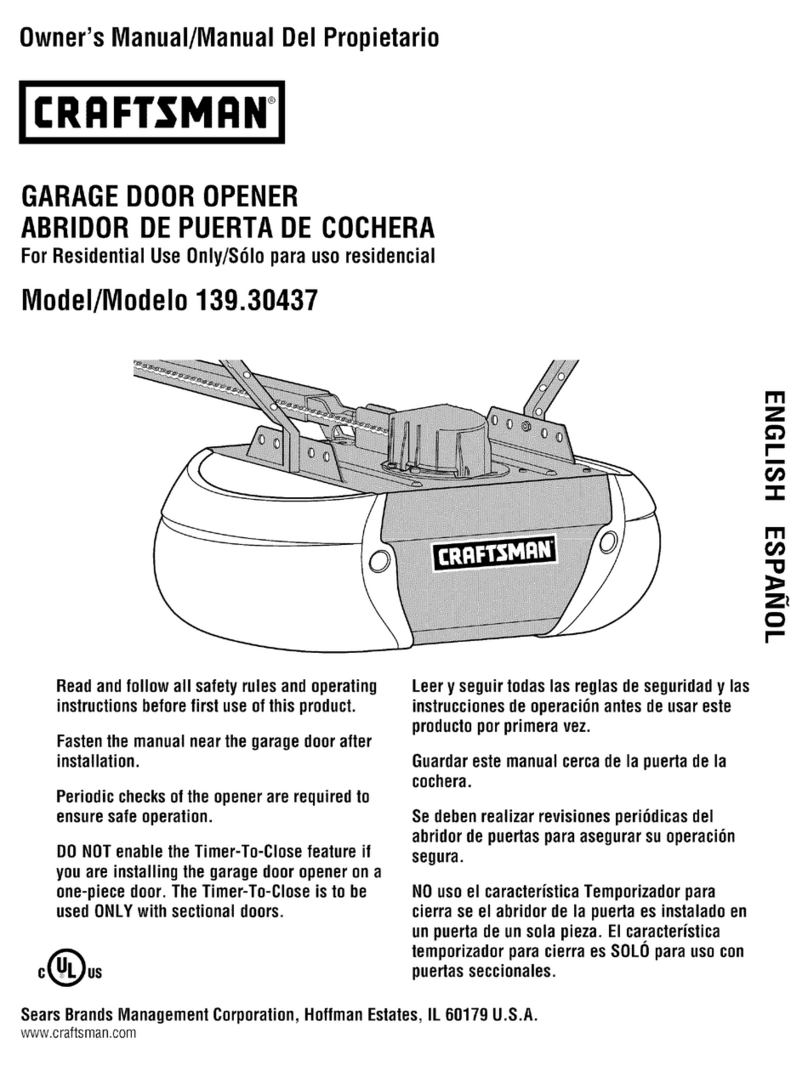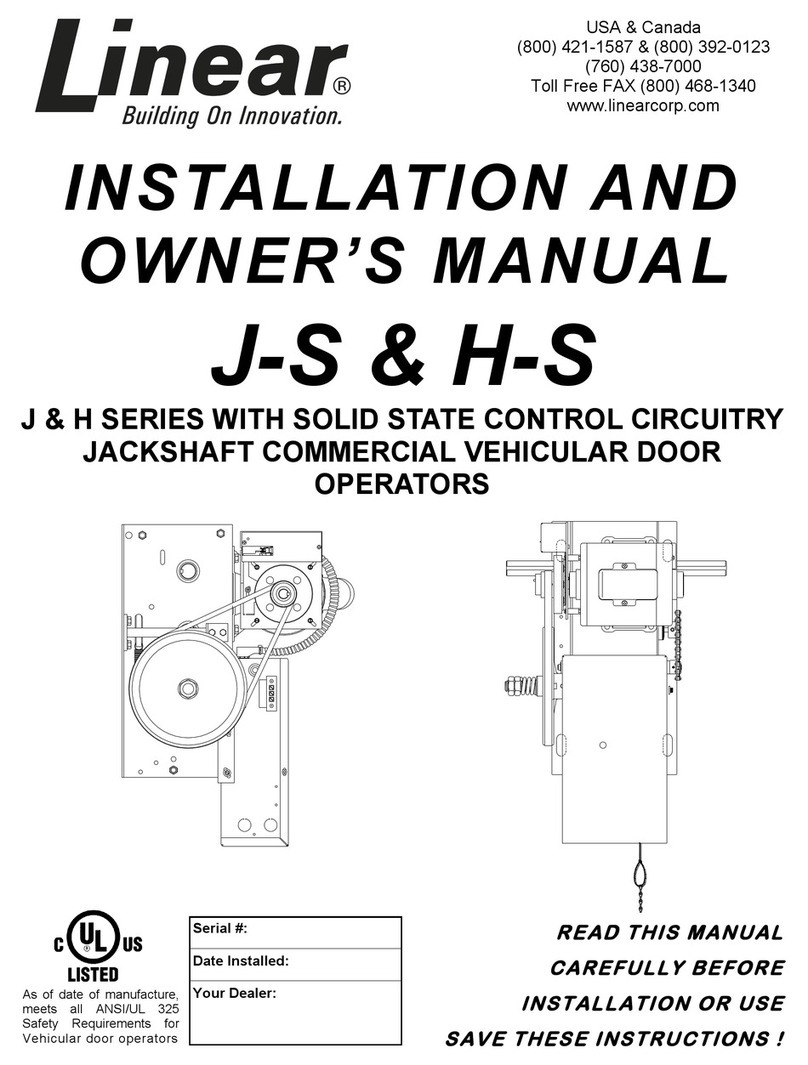featuring Controll-A-Door SDO-2V3 Tri-Tran+ Planning guide

Controll-A-Door®Prodigy
B&D Doors is a division of B&D Australia Pty Ltd
ABN 25 010 473 971
Doc #: 161017_00
Part #: 79094
Released: 30/07/14
Sectional Door Opener SDO-2V3 Tri-Tran+TM
Home Owner’s Manual

Controll-A-Door®Prodigy SDO-2V3 Tri-Tran+TM Home Owner’s Manual
2
Table of Contents
1. Safety Rules 3
2. Features 4
3. Specifications 5
4. Operating your door 6
5. User Operating Controls 7
6. Opener Safety & Security 8
6.1 Manual Door Operation 8
6.2 Emergency Evacuations 8
6.3 Power Failure 8
6.4 Re-Engaging the Opener 8
6.5 Security - Inbuilt Locking Facility 8
7. Safety Testing 9
7.1 Test the Close Cycle 9
7.2 Testing the Open Cycle 9
7.3 Test the Manual Door Operation 9
7.4 Setting the PET Mode position 9
8. Coding Transmitters 10
8.1 Storing the Transmitter Code 10
8.2 Setting the Transmitter to Operate the Courtesy Light 10
8.3 Setting Vacation Mode 10
8.4 Enabling AUX Output 11
8.5 Setting PET (Pedestrian) Mode 11
8.6 To Erase Programmed Codes 11
8.7 Installation of the Wall Mounted Transmitter 11
8.8 Remotely Coding Transmitters 11
9. Troubleshooting Guide 12
10. Maintenance 14
10.1 Door Maintenance 14
10.2 Lubrication (every 3 - 6 months) 14
10.3 Door Service and Repair 14
10.4 Opener Maintenance 15
10.5 Service Indicator 15
10.6 Removing the Battery From the Transmitter 15
11. Warranty 16
12. Optional Accessories 18
13. Service Schedule 19
WARNING! • When operating the manual release while the door is open, the
door may fall rapidly due to weak or broken springs, or due to being
improperly balanced.
• Do not disengage the opener to manual operation with children/persons
or any objects including motor vehicles within the doorway.
• If the door is closing and does not re-open when obstructed,
discontinue use. Do not use a door with faulty obstruction sensing.
ELECTROCUTION! • Place opener in protected area so that it does not get wet.
• Do not spray with water .
• Do not open the protective covers.
• Do not operate opener if cable is damaged.
CAUTION:
Emergency access • If your garage has no pedestrian entrance door, an emergency access
device should be installed. This accessory allows manual operation of
the garage door from outside in case of power failure.
Entrapment under
operating door
• Watch the moving door and keep people away until the door is
completely opened or closed. Do not operate door when persons are
near the door.
• Do not allow children to play with door controls or transmitters.
• Regularly conduct Open and Close cycle testing.
• Ensure the garage door is in good working order by undertaking regular
servicing.
• Wall transmitters should be installed in a location where the garage door
is visible, but out of the reach of children at a height of at
least 1.5m.
• Install Photo Electric Beams (recommended).
Fall from Ladder • Ensure ladder is the correct type for the job.
• Ensure ladder is on flat ground.
• Ensure user has 3 points of contact while on ladder.
Entanglement in or
laceration from
moving door
• Keep hands and loose clothing clear of door and guides at all times.
• Keep hands clear of moving door as sharp edges can cause cuts or
lacerations.
DO NOT DO IT
YOURSELF
• Keep the garage door balanced. Sticking or binding doors must be
repaired. Garage doors, door springs, brackets and their hardware are
under extreme tension and can cause serious personal injury. Do not
attempt any garage door adjustment. Do not use if repair or adjustment
is needed. Call for a professional garage door service.
DIY

Diamond PD Power Drive : Instruction
Manual
3
Controll-A-Door®Prodigy SDO-2V3 Tri-Tran+TM Home Owner’s Manual
© Copyright 2014 B&D Doors
Table of Contents
1. Safety Rules
B&D Doors to the extent that such may be lawfully excluded hereby expressly disclaims all conditions or warranties, statutory or otherwise which
may be implied by laws as conditions or warranties of purchase of a B&D Garage Door Opener. B&D Doors hereby further expressly excludes
all or any liability for any injury, damage, cost, expense or claim whatsoever suffered by any person as a result whether directly or indirectly from
failure to install the B&D Garage Door Opener in accordance with the installation instructions.
Please read these important safety rules
This automatic garage door opener is designed and tested to offer safe service provided it is
installed and operated in strict accordance with the following safety rules. Failure to comply with
the following instructions may result in death, serious personal injury or property damage.
WARNING! • When operating the manual release while the door is open, the
door may fall rapidly due to weak or broken springs, or due to being
improperly balanced.
• Do not disengage the opener to manual operation with children/persons
or any objects including motor vehicles within the doorway.
• If the door is closing and does not re-open when obstructed,
discontinue use. Do not use a door with faulty obstruction sensing.
ELECTROCUTION! • Place opener in protected area so that it does not get wet.
• Do not spray with water .
• Do not open the protective covers.
• Do not operate opener if cable is damaged.
CAUTION:
Emergency access • If your garage has no pedestrian entrance door, an emergency access
device should be installed. This accessory allows manual operation of
the garage door from outside in case of power failure.
Entrapment under
operating door
• Watch the moving door and keep people away until the door is
completely opened or closed. Do not operate door when persons are
near the door.
• Do not allow children to play with door controls or transmitters.
• Regularly conduct Open and Close cycle testing.
• Ensure the garage door is in good working order by undertaking regular
servicing.
• Wall transmitters should be installed in a location where the garage door
is visible, but out of the reach of children at a height of at
least 1.5m.
• Install Photo Electric Beams (recommended).
Fall from Ladder • Ensure ladder is the correct type for the job.
• Ensure ladder is on flat ground.
• Ensure user has 3 points of contact while on ladder.
Entanglement in or
laceration from
moving door
• Keep hands and loose clothing clear of door and guides at all times.
• Keep hands clear of moving door as sharp edges can cause cuts or
lacerations.
DO NOT DO IT
YOURSELF
• Keep the garage door balanced. Sticking or binding doors must be
repaired. Garage doors, door springs, brackets and their hardware are
under extreme tension and can cause serious personal injury. Do not
attempt any garage door adjustment. Do not use if repair or adjustment
is needed. Call for a professional garage door service.
DIY

Controll-A-Door®Prodigy SDO-2V3 Tri-Tran+TM Home Owner’s Manual
4
2. Features
Warranty
Five (5) year/20,000 cycles full parts and labour
warranty on motor, electronics and mechanical
components of the opener when installed by a
B&D Dealer (conditions such as annual garage
door servicing apply, refer to Section 11.3.b.i for
information)
Tri-Tran+™Technology
Only transmitters with the Tri-Tran+™Technology
can operate with the latest Openers, reducing the
chance of interference from other radio frequency
sources. Tri-Tran+™transmitters have the ability to
code into earlier model openers.
Code Hopping Technology
Every time a transmitter is used a new security code
is generated from over 100 billion possible code
combinations. This greatly enhances the security of
the system and makes “code grabbing” a thing of
the past!
Multi-Channel Transmitter
Multi-channel transmitters allow you to operate
other devices such as an adjoining garage door or
automated gate from the same handy unit.
Safety Reversing System
The automatic safety reverse system significantly
reduces the risk of death or serious injury if
trapped by a closing door. The safety reverse force
can be adjusted for environmental conditions such
as windy areas.
Memory Retention
In case of a power failure the opener does not lose
the transmitter codes or limit settings.
Soft Start/Soft Stop
The opener eases into and out of each cycle
making for smoother and quieter operation, as well
as reducing wear and tear on the door and opener.
Manual Release
The manual release handle allows the door to be
operated by hand in the event of a power failure.
Self Locking
There is no need to manually lock your garage
door, as the opener ‘positively’ locks the door when
closed.
Service Indicator
The opener has a built in service counter. From
factory this is loaded with 3000 cycles. When this
counter expires, the service yellow LED will light
up and at the start of each door movement the
beeper will sound three times. After opening or
closing the door the courtesy light will flash and
beeper sound five times. Contact your dealer/
installer for service. (Refer to Section 10.5 for
information).
Service Fault Indicator
Flashing LEDs on the control panel easily identify
operational problems or service requirements.
Dynamic Door Profiling
Changing door characteristics are automatically
compensated for and “learnt” with each
operation of the door.
Courtesy Light
The courtesy light automatically switches on for
approximately three (3) minutes when operating
the door. This can also be programmed to turn
on and off from a transmitter. (Refer to Section
8.2 for information).
Vacation Mode
A transmitter can be programmed to disable
the garage door opener radio receiver. This is
ideal if the door is to be left idle for prolonged
periods. (Refer to 8.3 for information)
Auxiliary Output
You can program a spare button on your remote
control transmitter to operate this output to
control items that can be switched using a
momentary close. (Refer to 8.4 for information)
Pet (Pedestrian) Mode
A transmitter can be programmed to open
the door partially to allow pets access to the
garage. The default PET Mode height can be
adjusted to a desired position. (Refer to 7.4 for
information). To code a transmitter button to
operate PET mode refer to 8.5 for information.
Networking Capabilities
To be advised . . .

Diamond PD Power Drive : Instruction
Manual
5
Controll-A-Door®Prodigy SDO-2V3 Tri-Tran+TM Home Owner’s Manual
© Copyright 2014 B&D Doors
3. Specifications
Technical Specifications
Power supply 230V - 240Va.c. 50Hz
Maximum door opening
Door Height (standard rail):
Maximum Door Height (with extension):
Door Area:
Door must be well balanced and able to be
operated by hand, as per warranty conditions
and AS/NZS 4505:2012
2440mm
3950mm
18m2
Minimum headroom 30mm
Short Term Peak force 1000N (100kg)
Rated Force 550N (55kg)
Nominal force 150N (15kg)
Receiver type Multi-frequency UHF FM
(433.47, 433.92 & 434.37MHz)
Receiver code storage capacity 64 X Tri-Tran+™4-button Transmitters
Coding System Tri-Tran+™Technology
Coding type Non-linear encryption algorithm
Number of code combinations Over 100 billion random codes
Transmitter battery CR2032 (3 Volts)
Courtesy light LED (Light Emitting Diodes)
Note: Intermittent operations may occur in areas which experience very strong winds. The strong wind
puts extra pressure on the door and tracks which may in turn intermittently trigger the safety obstruction
detection system.

Controll-A-Door®Prodigy SDO-2V3 Tri-Tran+TM Home Owner’s Manual
6
Fig. 4.1
Transmitter
•To operate the opener, press the programmed
transmitter button until your door begins to move
(usually 2 seconds). Make sure you can see the
door when you use the transmitter.
•If you are in a vehicle you should aim the
transmitter through your windscreen (Fig. 4.1).
•Check that the door is fully closed before you
drive away.
•If you press the transmitter whilst the door is
moving the door will stop. The next press of the
transmitter will move the door in the opposite
direction.
The transmitter may also be programmed to operate
the following features (Refer to Section 8 for full
details):
•Turn the courtesy light on and off without
operating the door,
•Put the garage door opener into “Vacation Mode”
where it will not respond to any transmitters.
NOTE: Additional transmitters may be purchased at
any time.
For maximum efficiency of your opener, your garage
door must be in good operating condition.
An annual service of your garage door by a Dealer is
recommended.
4. Operating your door
CAUTION: Activate the opener only
when the door is in full view, free of
obstructions and with the opener
properly adjusted. No one should enter
or leave the garage while the door is in
motion. Do not allow children to play
with or near the door.
ELECTROCUTION! This opener is a
mains voltage plug-in domestic appliance
and there are no user serviceable parts
inside this opener.

Diamond PD Power Drive : Instruction
Manual
7
Controll-A-Door®Prodigy SDO-2V3 Tri-Tran+TM Home Owner’s Manual
© Copyright 2014 B&D Doors
5. User Operating Controls
Button (Fig 5.1) Function
1. OPERATE Opens/stops/closes the door
2. SERVICE LED (Yellow) Indicates when the opener requires service or repairs
3. CODE SET LED (Red) Flashes when a transmitter button is pressed.
4. OPEN LED (Green) Illuminates and flashes as the door opens and remains on when
the open limit position has been reached.
5. CLOSE LED (Red) Illuminates and flashes as the door opens closes, and remains on
when the close limit position has been reached.
6. CODE SET Press and hold until CODE SET LED starts flashing and this will
delete all transmitter storage memory
Door Status Indicators OPEN LED (green) CLOSE LED (red) Beeper
Open On
Close On
Opening Flashing
Closing Flashing
Door travel stopped Flashing Flashing
Door obstructed when
opening
Flashing Beeps while door
is moving
Door obstructed when
closing
Flashing Beeps while door
is moving
Opener overloaded Alternating flashes Alternating flashes
Door in open position with
Auto-Close mode selected
One second flashes
Mains power interrupted Rapid flashes
Fig. 5.1
04
05
06
01
02
03

Controll-A-Door®Prodigy SDO-2V3 Tri-Tran+TM Home Owner’s Manual
8
Shuttle Assembly
Chain Index
Fig. 6.2
Fig. 6.1
6. Opener Safety & Security
WARNING! When operating the
manual release (while the door is
open) the door may fall rapidly due
to weak or broken springs, or due to
being improperly balanced.
Do not disengage the opener to
manual operation with children/
persons or any objects including
motor vehicles within the doorway.
6.2 Emergency Evacuations
In emergencies the garage door can be disengaged
from the opener, via the manual release cord and
the door opened manually. The manual release cord
should be a maximum of 1.8m from the ground. The
cord can be adjusted for special considerations.
6.3 Power Failure
When there is a power failure, the opener will be
unable to automatically open or close your garage
door. To use your door whilst there is no power you
will need to disengage the opener and use the door
manually – see 6.1 Manual Door Operation.
6.4 Re-Engaging the Opener
When the door has been disengaged from the
opener, the shuttle assembly, attached to the manual
release cord, can move up and down the chain.
Re-engage the opener (Fig 6.1) (preferably with
the door open to waist height) and then press the
programmed transmitter button, the motor will run
until the shuttle assembly engages the chain index
(Fig 6.2), you will hear it click into place. Then the
door will operate as normal.
CAUTION: When the opener is manually
disengaged, the door is no longer locked.
To lock the door manually, re-engage the
opener after the door is closed.
6.1 Manual Door Operation
To disengage the opener from the door (preferably
with the door in the closed position), pull down
on the string handle on an angle towards the door
(Fig 6.1). This will allow you to manually open or
close the door.
To re-engage the opener pull the string handle away
from the door - see 6.4 Re-Engaging the Opener.
6.5 Security - Inbuilt Locking Facility
DO NOT lock your door when your opener is
engaged as it has inbuilt locking facility. With the
opener engaged your door will be locked whether
the power is on or off.
CAUTION: Do not use the string handle
as a mechanism to open the door. Failure
to comply may cause serious injury.

Diamond PD Power Drive : Instruction
Manual
9
Controll-A-Door®Prodigy SDO-2V3 Tri-Tran+TM Home Owner’s Manual
© Copyright 2014 B&D Doors
7. Safety Testing
6. Opener Safety & Security
Fig. 7.2
Fig. 7.1
WARNING! If the door is closing
and is unable to re-open when
obstructed, discontinue use.
Do not use a door with faulty
obstruction sensing. Contact
your dealer for support.
7.1 Test the Close Cycle
a. Press the transmitter to open the door. (Fig 7.1)
b. Place a piece of timber approximately 40mm high on
the floor directly under the door (Fig 7.2).
c. Press the programmed transmitter to close door.
d. The door should strike the object and re-open.
7.2 Testing the Open Cycle
a. Press the transmitter to close the door (Fig. 7.1).
b. Press again to open the door.
c. When the door reaches approximately half way,
firmly grab the door’s bottom rail - the door should
stop.
If the door does not reverse readily when closing, or
stop when opening, put the door into manual and
contact your installer immediately for a door service.
7.3 Test the Manual Door Operation
Periodically disengage the opener (Section 6.1) and
manually operate the door. The door must be smooth to
operate by hand. The force required on the bottom rail
should not exceed 15 kg.
7.4 Setting the PET Mode position
When activated, PET mode drives the door to the preset
position from the close position.
a. Drive and stop the door at the desired PET mode
open position by pressing the transmitter button
coded for Open/Stop/Close operation.
b. Press and hold the OPEN button on the opener for
six (6) seconds until the OPEN and CLOSE LED’s are
lit to record the new PET position.
To program a transmitter button to operate PET mode
refer to 8.5 Setting PET Mode.
Periodically test if a PET mode button is pressed, while
the door is moving, the door will stop or when the door is
in the PET position, the door will close.
40mm
Select the button on
the transmitter that has
been programmed to
operate the door.
If transmitter is not programmed,
Refer to Section 8 to program
transmitter.
CAUTION: Take care when
completing a safety test. Failure
to follow this warning can result
in serious personal injury and/or
property damage.

Controll-A-Door®Prodigy SDO-2V3 Tri-Tran+TM Home Owner’s Manual
10
8. Coding Transmitters
Press
CODE SET
button once
Select one of the
four buttons you
wish to use to
control the door
Fig. 8.1
ELECTROCUTION! The button
cover is the only cover that should
be removed. All other covers must
remain in place.
CAUTION: Be careful not to press
the operate button while removing
the button cover as the door will
start to move.
IMPORTANT NOTE: Only Tri-Tran+™
Technology Transmitters are compatible
with this SDO-2V3 product.
8. Coding Transmitters
b. Choose a transmitter button not already
coded into the receiver. Press this button and
the CODE SET LED will begin to flash.
c. Press the same transmitter button again. The
CODE SET LED will illuminate for one second
and then go out, and the courtesy light will
also switch off. This indicates the code has
been stored.
d. To activate Vacation Mode, close the garage
door and press the coded button transmitter
for 5 seconds. The CODE SET LED will
illuminate to indicate that the opener is in
Vacation Mode.
e. To exit Vacation Mode press the transmitter
button momentarily until the CODE SET LED
turns off.
8.1 Storing the Transmitter Code
The opener can only operate from transmitters that
have been programmed into its receiver. The receiver
needs to learn the codes of any transmitter that will be
used with the operator. Up to sixty four (64) codes can
be stored in the receiver’s memory.
a. Press the CODE SET button and release. The
CODE SET LED will illuminate to indicate the
opener is in Code Learn mode. If a valid code is
not stored within 15 seconds the opener will exit
Code Learn (Fig. 8.1).
b. Press the transmitter button (one of four) that you
want to control the door. The CODE SET LED will
begin to flash.
c. Press the same transmitter button again. The
CODE SET LED will illuminate for one second and
then go out.
d. The transmitter is now coded to operate the door -
press the button to test.
8.2 Setting the Transmitter to Operate the
Courtesy Light
Although the courtesy light comes on with each
operation of the opener, it may also be controlled by a
transmitter without operating the door.
a. Press the CODE SET button twice. The CODE
SET LED will illuminate and the courtesy light will
turn on to indicate that the light code learning is
active.
b. Choose a transmitter button not already coded
into the receiver. Press this button and the CODE
SET LED will begin to flash.
c. Press the same transmitter button again. The
CODE SET LED will illuminate for one second and
then go out.
d. The transmitter is now coded to operate the light.
Press the button to test.
8.3 Setting the Transmitter to Operate
Vacation Mode
The opener can be programmed into a “Vacation
Mode” where the opener will not respond to any
transmitter except one preprogrammed unit.
a. Press CODE SET button three times. The CODE
SET LED will illuminate and the courtesy light will
flash slowly (once every two seconds) to indicate
Vacation learning mode is active.

Diamond PD Power Drive : Instruction
Manual
11
Controll-A-Door®Prodigy SDO-2V3 Tri-Tran+TM Home Owner’s Manual
© Copyright 2014 B&D Doors
8. Coding Transmitters
Fig. 8.3
8.4 Enabling AUX Output
a. Press the CODE SET button four (4) times - the CODE SET LED will illuminate and the courtesy light
will flash quickly.
b. Press one of the four (4) buttons on the transmitter for two (2) seconds, the CODE SET LED will begin
to flash, pause for two (2) seconds, then press the same button again for two (2) seconds. The CODE
SET LED will illuminate for one second then go out.
c. Press the transmitter button to test.
8.5 Setting PET (Pedestrian) Mode
The PET mode position is set during installation.
a. Press the CODE SET button five (5) times - the CODE SET LED will illuminate and the courtesy light
will flash quicky (twice per second).
b. Press one of the four (4) buttons on the transmitter for two (2) seconds, the CODE SET LED will begin
to flash, pause for two (2) seconds, then press the same button again for two (2) seconds.
c. The CODE SET LED will illuminate for one second and then go out, and the courtesy light will also
switch off. This indicates the code has been stored.
d. Press the transmitter button to test.
Fig. 8.2
8.6 To Erase Programmed Codes
If the CODE SET button is pressed and held for six (6)
seconds the CODE SET LED will blink rapidly for one
second to indicate that all programmed codes have
been erased.
8.7 Installation of the Wall Mounted
Transmitter
a. Mount the transmitter in a convenient location, yet
out of reach of children and at least 1.5m off the
ground (Fig. 8.2).
b. Make sure the door is visible from this location.
c. To set the transmitter codes refer to 8.1.
8.8 Remotely Coding Transmitters
Using this method transmitters can be coded without
access to the opener’s control panel as long as a
pre-coded transmitter is available.
a. Take any pre-coded transmitter. Press the button
for the function to be duplicated and release.
b. Using a small needle / pen, press and hold firmly
for two seconds the middle button, through the
Coding Hole (Fig. 8.3).
c. Within ten (10) seconds take the additional
transmitter you wish to code. Hold the new
transmitter’s button for two seconds, pause for
two seconds, hold again for two seconds and then
release.
d. Wait for ten (10) seconds and then press the new
transmitter’s button to test.

Controll-A-Door®Prodigy SDO-2V3 Tri-Tran+TM Home Owner’s Manual
12
9. Troubleshooting Guide
Symptom Possible cause Remedy
The opener does
not work from the
transmitter
Garage door in poor condition e.g.
springs may be broken
The opener does not have power
The battery in the transmitter is flat
Transmitter does not contain
Tri-Tran+™Technology
The opener has been put into
“Vacation Mode”
The transmitter button is not
programmed to operate the door.
Door Code LED is flashing yet the
opener is not working.
Check the door’s operation - see
monthly maintenance (Section 10.1)
Plug a device of similar voltage
(e.g. a hairdryer) into the power
point and check that it is OK
Replace the battery (Section 10.6)
Check that the transmitter has grey
buttons and the model number
on the back displays V2. Contact
dealer for support if otherwise.
Turn off “Vacation Mode”
(Section 8.3, step e)
See coding transmitter procedure
(Section 8.1)
Ensure the correct button on the
transmitter is being pressed.
The chain moves but the
door remains stationary
The opener is disengaged Re-engage the opener
(Section 6.4)
Motor is running but
chain is not moving
Damage motor assembly Contact your dealer for support.
The transmitter range
varies or is restricted
Variations are normal depending
on conditions e.g. temperature or
external interference
The battery life is exhausted
Position of the transmitter in the
motor vehicle
See instructions for correct use of
transmitter (Section 4)
Refer to battery status (Fig 10.3)
Change the position (Section 4)
The Courtesy light does
not work
LED has failed Contact your dealer for support
The door reverses for no
apparent reason
This may occur occasionally from
environmental conditions such as
areas that are windy, dusty or have
extreme temperature changes.
If Safety beams are installed they
may be partially obstructed.
Put the door into manual (Section
6.1, take note of the CAUTION) and
contact your dealer.
Ensure the beam path is not
obstructed. If continues, contact
your dealer.
The door opens but will
not close
Safety Beam (Optional Accessory)
not operating correctly
Contact your dealer for support

Diamond PD Power Drive : Instruction
Manual
13
Controll-A-Door®Prodigy SDO-2V3 Tri-Tran+TM Home Owner’s Manual
© Copyright 2014 B&D Doors
9. Troubleshooting Guide
If You Need a Service Call
If the opener needs a service please call the dealer
who installed the garage door opener (their contact
details are usually on a sticker on the back of your
garage door). For product assistance contact 13 62 63
within Australia.
Symptom Possible cause Remedy
The door stops or moves
very slowly under battery
(Optional Battery Back
Up Accessory)
The batteries may have little to
no charge
Connect mains power and leave the
batteries to charge. The batteries
may take 24 to 48 hours to reach
their maximum charge capacity.
Courtesy Light flashes
and the opener beeps
5 times after each
operation
The opener has reached
the number of cycles
recommended before servicing.
See (Section 10.5) Contact your
dealer and arrange a door service.
Alternatively press CODE SET button
once to reset the service counter.
The SERVICE LED has
started to flash and is
beeping numerous times
A Fault has been detected. The
fault will be active each time an
attempt is made to operate the
door.
Record opener function in (Fig 9.1)
then press the CODE SET button
once to reset the opener. If the fault
continues to be tripped contact your
dealer for support.
The Open (Green) LED
and Close (Red) LED are
flashing alternatively
Opener is overloaded Discontinue use and Contact your
dealer for support.
The Open (Green) LED
continues to flash
Door obstructed when opening Clear away any obstructions and
test door opens correctly. (If door is
damaged, contact your dealer).
The Close (Red) LED
continues to flash
Door obstructed when closing
Limits may be cleared
Clear away any obstructions and
test door closes correctly. (If door is
damaged, contact your dealer).
Remove all power sources (including
the battery backup). Wait till all lights
are out (10-15 secs), then reconnect
power. If Red LED is flashing,
limits are not set. Contact dealer
immediately and discontinue use.
BEFORE CALLING you should have the following
information to assist in providing the appropriate service:
1. Has anything happened since the opener last operated OK, e.g. a storm, a jolt to the door etc.?
2. What is the current light status on the opener?
3. Manually disengage the door (Section 6.1).
How easy is it to manually open and close the door?
4. What model is the opener? (Model no. information is located at the rear of the opener)
5. Who installed the opener? (Dealer details should be on a sticker on the back of your garage door)
6. When was it installed? (If known)
Symptom Possible cause Remedy
The opener does
not work from the
transmitter
Garage door in poor condition e.g.
springs may be broken
The opener does not have power
The battery in the transmitter is flat
Transmitter does not contain
Tri-Tran+™Technology
The opener has been put into
“Vacation Mode”
The transmitter button is not
programmed to operate the door.
Door Code LED is flashing yet the
opener is not working.
Check the door’s operation - see
monthly maintenance (Section 10.1)
Plug a device of similar voltage
(e.g. a hairdryer) into the power
point and check that it is OK
Replace the battery (Section 10.6)
Check that the transmitter has grey
buttons and the model number
on the back displays V2. Contact
dealer for support if otherwise.
Turn off “Vacation Mode”
(Section 8.3, step e)
See coding transmitter procedure
(Section 8.1)
Ensure the correct button on the
transmitter is being pressed.
The chain moves but the
door remains stationary
The opener is disengaged Re-engage the opener
(Section 6.4)
Motor is running but
chain is not moving
Damage motor assembly Contact your dealer for support.
The transmitter range
varies or is restricted
Variations are normal depending
on conditions e.g. temperature or
external interference
The battery life is exhausted
Position of the transmitter in the
motor vehicle
See instructions for correct use of
transmitter (Section 4)
Refer to battery status (Fig 10.3)
Change the position (Section 4)
The Courtesy light does
not work
LED has failed Contact your dealer for support
The door reverses for no
apparent reason
This may occur occasionally from
environmental conditions such as
areas that are windy, dusty or have
extreme temperature changes.
If Safety beams are installed they
may be partially obstructed.
Put the door into manual (Section
6.1, take note of the CAUTION) and
contact your dealer.
Ensure the beam path is not
obstructed. If continues, contact
your dealer.
The door opens but will
not close
Safety Beam (Optional Accessory)
not operating correctly
Contact your dealer for support
Fig. 9.1
Date Time Number of
Beeps

Controll-A-Door®Prodigy SDO-2V3 Tri-Tran+TM Home Owner’s Manual
14
10. Door Maintenance
10.1 Door Maintenance
Whilst your opener does not require any periodic
maintenance, the door that it is fitted to, does.
Your garage door is a large, heavy, moving
object and should be tested regularly to ensure
it is in good condition. A poorly maintained door
could cause fatal / serious injuries or damage to
property.
•Frequently examine the door, particularly the
cables, springs and mountings for signs of
wear, damage or imbalance. DO NOT USE if
repair or adjustment is needed since a fault
in the installation or an incorrectly balanced
door may cause injury.
10.2 Lubrication (every 3 - 6 months)
To ensure a long and trouble free life for your
door the following is recommended:
•Guide Tracks: Clean the internal sections of
the guide tracks with a cloth dampened with
mineral turps or methylated spirits.
•Steel Hinges (if fitted): Sparingly lubricate
with an all-purpose machine oil. Also lubricate
wheel to axle bearings.
•Plastic Hinges: No lubrication is generally
required; however silicon spray may be used
if necessary.
•Springs: If accessible wipe over with an oily
rag.
10.3 Door Service and Repair
If correct maintenance and servicing are not
carried out, warranty may be void. To keep your
door running well, it is recommended that your
door be serviced by an experienced technician,
every 12 months or earlier if required:
•Lifting Cables (if fitted): Check for wear
through rubbing. If there is fraying or signs
of corrosion contact your dealer immeditately
and discontinue use, leaving door in the
closed position.
•Fasterners: Check all screws, nuts and bolts to
ensure they are secure.
•Spring Tension: It is natural for springs to
lose tension. Should the door become hard
to operate or completely inoperative, contact
your dealer.
DO NOT DO IT YOURSELF:
Door adjustments should only be
carried out by experienced persons,
as this function can be dangerous
if not performed under strict safety
procedures.
WARNING! Failure to maintain your
garage door may void the warranty
on your garage door opener.
DIY
CAUTION: Disconnect the opener
power cord from the mains power
before conducting any lubrication
maintenance, to ensure no
entanglement if the door is activated.

Diamond PD Power Drive : Instruction
Manual
15
Controll-A-Door®Prodigy SDO-2V3 Tri-Tran+TM Home Owner’s Manual
© Copyright 2014 B&D Doors
10.4 Opener Maintenance
To ensure a long and trouble free life for your
opener the following is recommended:
•Monthy: Run the Safety Testing procedures in
Section 7 to ensure garage door is fit for use.
NOTE: If the door does not operate smoothly, call
your nearest Approved Dealer.
10.5 Service Indicator
While the door opener does not require regular
servicing, to function correctly the door must be
in good operating condition. As a reminder the
CAD Prodigy has a built in maintenance counter.
This counter has a factory default of 3000 cycles,
which is the recommended service interval.
When this counter expires the yellow SERVICE
LED will light up and opener beep three times at
the start of each cycle (Fig. 10.1). In addition the
courtesy light will flash and opener beep five times
at the end of open cycle (when the door is fully
open).
These warning signals will self extinguish after 30
cycles. When this service counter is triggered it is
strongly recommended you contact your garage
door dealer to arrange a door service. See Section
13 for Recommended Service Schedule.
However, if you choose not to have your door
serviced the counter can be reset simply by
pressing the LIMIT SET button.
10.6 Removing the Battery From the
Transmitter
(Battery Type: 3V Lithium Battery CR2032).
Use a non-metallic object (e.g. pen) to remove the
battery. (Fig. 10.2). To test the battery is working,
press and hold a transmitter button; (Fig. 10.3).
Light Status Battery Status
Solid OK
Flashing Requires replacement
No light Requires replacement
10. Opener Maintenance
Fig. 10.2
BEEP
Fig. 10.1
Fig. 10.3
REPLACE BATTERY WITH CR2032 ONLY
Use a pen
to push the
battery down
through the
side openeing
to release
battery

Controll-A-Door®Prodigy SDO-2V3 Tri-Tran+TM Home Owner’s Manual
16
Product: CAD Prodigy SDO-2V3 Tri-Tran+™
Purchased from:______________________________Purchaser:___________________________________
(described as “you” below)
Address:_____________________________________Installed by:__________________________________
Installed on (date):____________________________Invoice No:__________________________________
1. MAKING A CLAIM -
To make a warranty claim you must:
a. produce a copy of the receipt of purchase, together with this warranty certificate with the above details completed; and
b. where the Product has been sold by B&D, make all warranty claims directly with B&D by sending it to B&D at the relevant
address set out in paragraph 2 below; or
c. where the Product has been sold by an approved distributor, make all warranty claims directly with the approved
distributor. If you are unsure of the correct address of the approved distributor from which you purchased the product,
you can send your claim to B&D with the rest of the above details completed, including the original invoice number, and
we will forward it to the distributor.
You are responsible for the expense of making a claim under this warranty.
2. B&D OR APPROVED DISTRIBUTORS ONLY -
This warranty is in addition to any statutory, non-excludable guarantees or warranty rights under Australian or New Zealand
laws (as applicable). This warranty applies only to Products sold by B&D or its approved distributor. “B&D” means in
Australia - B&D Doors of 34 – 36 Marigold St, Revesby NSW 2212 and in New Zealand - B&D Doors (NZ) Limited of 30C
Allens Road, East Tamaki Auckland. “Approved distributor” means an approved reseller of B&D products purchasing on
open account, from B&D, for the purpose of supplying those products to end users.
3. WHAT THE WARRANTY COVERS -
B&D warrants, subject to paragraph 4, that it will, at its option, either repair or replace (in a manner B&D considers
reasonable) any proven defects:
a. in installation for a period of one year from the date of installation where the CAD Prodigy (Product) has been installed
by B&D or its approved distributor;
b. in materials, manufacture or workmanship in the Product, as follows:
i. for all components of the Product that make up the power head (including any track assembly) that is attached to a
garage door and that are installed by B&D or an approved distributor, the warranty will be valid for a period of five
years or 20,000 cycles, which ever occurs first, provided that the Product is serviced annually by B&D or its approved
distributor;
ii. for all components of the Product that make up the power head (including any track assembly) that is attached to a
garage door and that are not installed by B&D or an approved distributor, the warranty is valid for a period of one
year, provided that all costs of disconnection, reinstallation and return freight are to be borne by you;
iii. for all other components of the Product the warranty is valid for a period of one year; and
in each case the warranty applies from the later of the date of purchase, delivery or installation by B&D or an approved
distributor (as applicable).
4. WHAT THE WARRANTY DOES NOT COVER -
This warranty does not cover:
a. batteries or globes - B&D will not be liable for any defect or failure in them;
b. adjustments - (as described in the Instruction Manual provided with the Product) which are not defects - you will need to
pay for any service calls for adjustments;
c. model modifications - B&D will not be required to incorporate modifications made to existing/future Product models;
d. travel expenses - incurred by B&D or its approved distributor in either travelling to and from or transporting the Product
to/from areas outside a capital city metropolitan area - you will need to pay for these expenses; or
e. additional access expenses - incurred by B&D or an approved distributor in obtaining access where the Product is not
readily accessible - you will need to pay for those additional expenses.
11. Warranty

Diamond PD Power Drive : Instruction
Manual
17
Controll-A-Door®Prodigy SDO-2V3 Tri-Tran+TM Home Owner’s Manual
© Copyright 2014 B&D Doors
5. WHAT VOIDS THE WARRANTY -
Subject to paragraph 6, this warranty does not extend to, and B&D will be relieved of, all obligations, responsibilities and
liabilities in the event that defects in the Product are directly or indirectly, in the opinion of B&D, due to or resulting from:
a. unreasonable use - the Product not being used correctly in accordance with the Instruction Manual or other unreasonable
use;
b. instructions - failure to observe any instructions or directions (including “warning” notifications in the Instruction Manual),
provided with the Product or given to you;
c. other devices - the Product being fitted to any door or other closing device which is not of the type or condition defined
in the Instruction Manual as suitable for installation of the Product;
d. installation or adjustment - faulty installation or adjustment of the Product or door to which the Product is connected
where such installation or adjustment is not carried out by B&D or its approved distributors;
e. unauthorised acts - modifications or repairs made or attempted to be made by you or any unauthorised person;
f. service - lack of proper maintenance, service or care of the door and Product;
g. outside control - events or acts beyond the reasonable control of B&D;
h. settings - use with doors locked or operation of the Product with excessively high opening or closing force settings
i. wiring - faulty electrical wiring of structures to which the Product is affixed;
j. interference - radio (including citizen brand transmissions) or other electronic interference;
k. water damage - including effects from rust and corrosion);
l. salt - salt corrosion or damage to the surface coatings or base materials due to environmental conditions (such as
proximity to the sea-front or similar corrosive conditions).
m. continuous operating time - maximum continuous operating time exceeding 1 minute in 10;
n. maximum operating force – the operating force exceeding 15kg* (150 Newton) when moving the door manually to the
open or closed position;
o. door size – the door surface area exceeding 18.0m2;
p. modifications - any unauthorised modification to the Product;
q. insects damage - damage caused by insects; or
r. non-residential use – installation of a residential garage door opener in a commercial or industrial premises or in a
dwelling other than a single-family dwelling.
6. STATUTORY GUARANTEES OR WARRANTIES –
Australia
If you are a consumer under the Australian Consumer Law, our goods come with guarantees that cannot be excluded
under the Australian Consumer Law. You are entitled to a replacement or refund for a major failure and for compensation
for any other reasonably foreseeable loss or damage. You are also entitled to have the goods repaired or replaced if the
goods fail to be of acceptable quality and the failure does not amount to a major failure.
This warranty certificate and other statements contained in this document or other B&D documents given to you do not
exclude, restrict or modify the application of all or any of the provisions of the Australian Consumer Law.
New Zealand
This warranty certificate and other statements contained in this document or other B&D documents given to you do not
exclude, restrict or modify the application of the New Zealand Consumer Guarantees Act (collectively defined as the “Act’);
or the exercise of rights conferred by other statutory provisions which cannot be excluded, restricted or modified, provided
that to the extent that the Act or other statutory provision permits B&D to limit its liability for a breach of a statutory
guarantee or warranty, B&D’s liability for such breach is limited to the payment of the cost of replacing the Product or
acquiring an equivalent Product or repairing the Product.
In Australia, this warranty is given by B&D Australia Pty Limited (ABN 25 010 473 971) of B&D Doors of 34 – 36 Marigold
St, Revesby NSW 2212, phone 13 62 63 and email [email protected]. In New Zealand, this warranty is given by BD
Doors (NZ) Limited of 30C Allens Road, East Tamaki, Auckland, phone 09-273 8600 and email [email protected]
This warranty document is not intended to create a contract between B&D and the purchaser.
NOTES:
1. * The door that the Product is used with should be balanced in such a way that the user is able to open or close
the door manually using a force not greater than 150 Newton (15 kg), other than to initially cause the door to start
moving, which may require force in excess of that specified in this paragraph.
11. Warranty

Controll-A-Door®Prodigy SDO-2V3 Tri-Tran+TM Home Owner’s Manual
18
12. Optional Accessories
There are a range of additional accessories for your added convenience and security. Contact your
Dealer for installation of these accessory items.
•Wireless Safety Beams - Provides additional protection
if the door is closing onto your property or person. Simply
breaking the beam “stops” the door!
•Keyring Transmitter - Ideal for personal use when entry into
the house may be via the garage.
•Wall Button Transmitter - Allows you to operate the opener
within 10 metres of the door. Ideal for mounting inside the
house.
•Wireless Keypad - The entry keypad allows entry to the
garage without using a transmitter.
•Battery Back-up - The opener has a provision for a Battery
Back Up kit that allows continued operation of the door in the
absence of mains power.
•External Antenna - For sites where radio range may be
reduced.
IMPORTANT NOTE:
Only Tri-Tran+™Technology
Transmitters and Keypads are
compatible with this SDO-2V3
product.

Diamond PD Power Drive : Instruction
Manual
19
Controll-A-Door®Prodigy SDO-2V3 Tri-Tran+TM Home Owner’s Manual
© Copyright 2014 B&D Doors
13. Service Schedule
B&D Doors is a division of B&D Australia Pty Ltd
Phone: 13 62 63
Website: www.bnd.com.au
Year /
Approx. Cycles
Date Details
1 / 3,000
2 / 6,000
3 / 9,000
4 / 12,000
5 / 15,000

Controll-A-Door®P Diamond SDO-2 Home Owner’s Manual
20
B&D Doors is a division of B&D Australia Pty Ltd
ABN 25 010 473 971
Controll-A-Door®Prodigy
Sectional Door Opener SDO-2V3 Tri-Tran+TM
Home Owner’s Manual
Is your opener beeping
and flashing?
It may be time for a service
(for more details see section 10.5)
For a service contact your dealer using
the details below...
Dealer:
Table of contents
Popular Garage Door Opener manuals by other brands
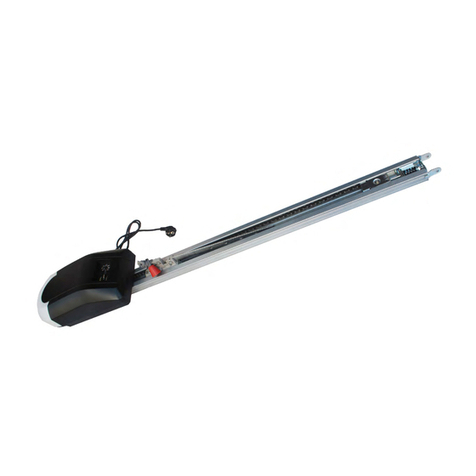
East
East 800NM1 user manual

Keyautomation
Keyautomation TURBO 250 Instructions and warnings for installation and use
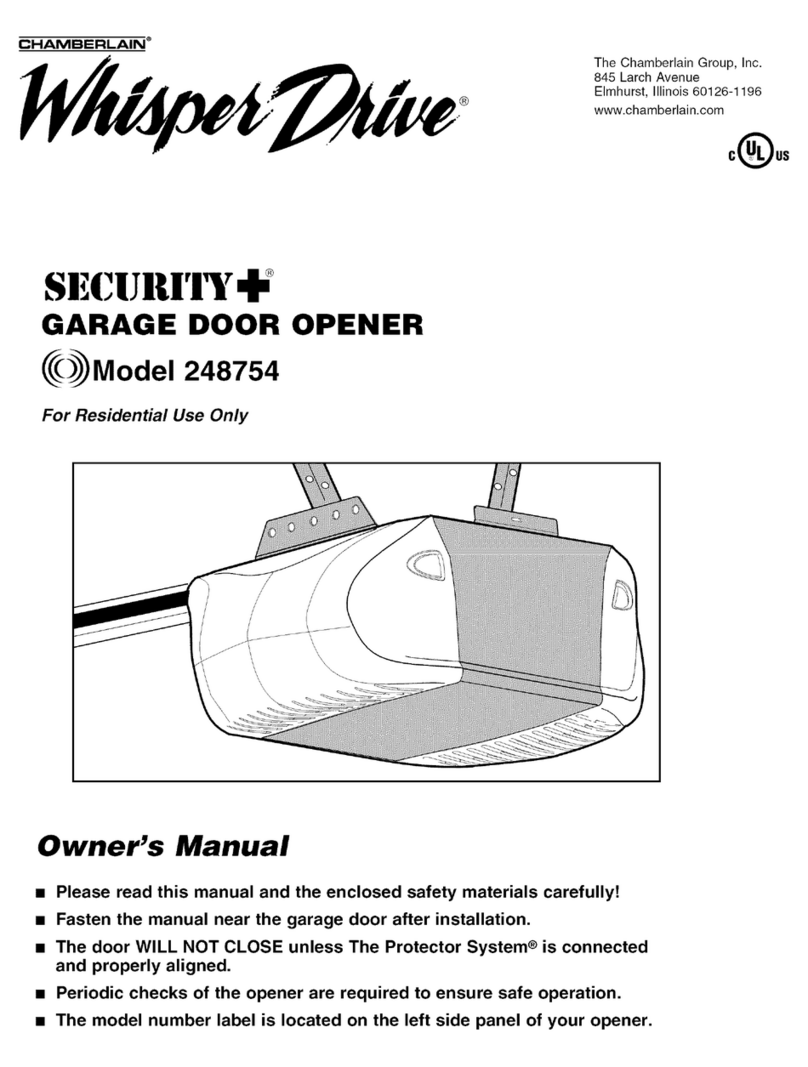
Security +
Security + WhisperDrive 248754 owner's manual

Chamberlain
Chamberlain 3595C 3/4 HP owner's manual
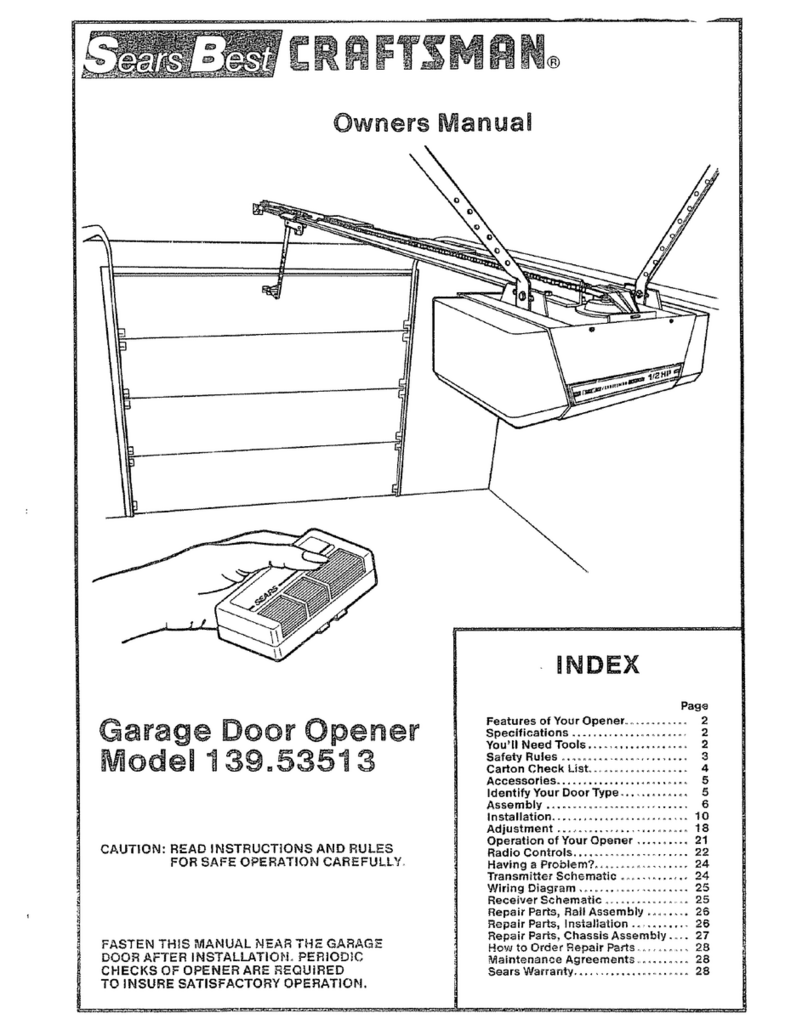
Craftsman
Craftsman 139.53513 owner's manual
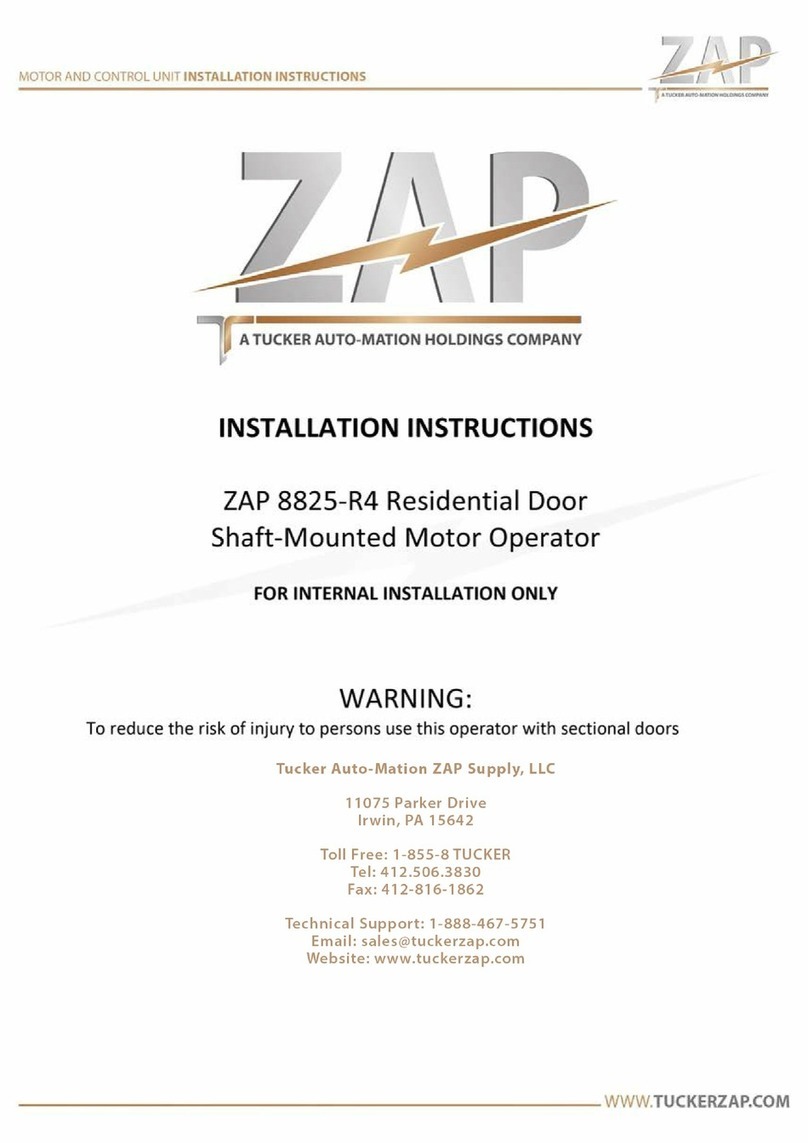
Zap
Zap 8825-R4 installation instructions
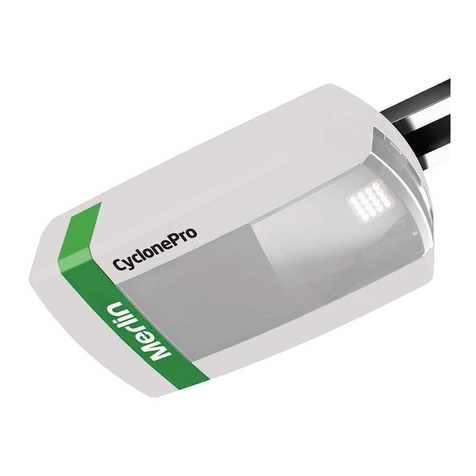
Merlin
Merlin CYCLONE PRO MT120EVO Installation and operating instructions

Chamberlain
Chamberlain Merlin Whisper Drive MT3850EVO Installation and operating instructions
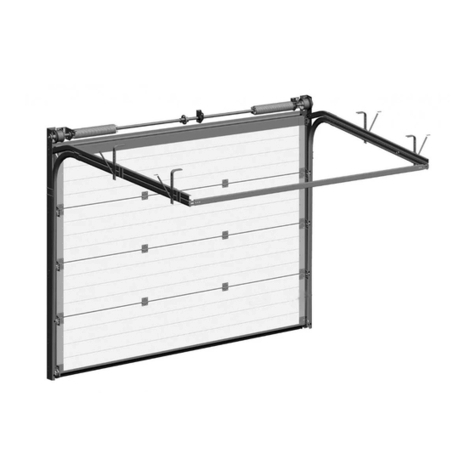
DoorHan
DoorHan RSD01S Series Service book
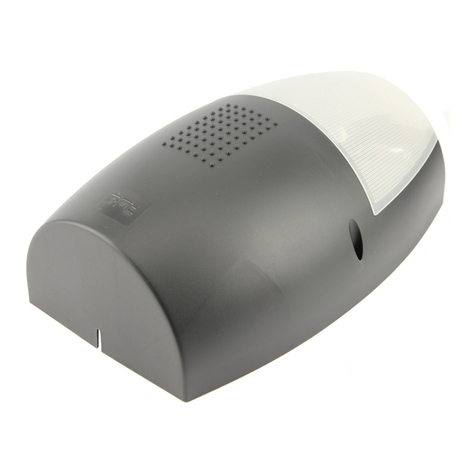
BFT
BFT BOTTICELLI VENERE Installation and user manual
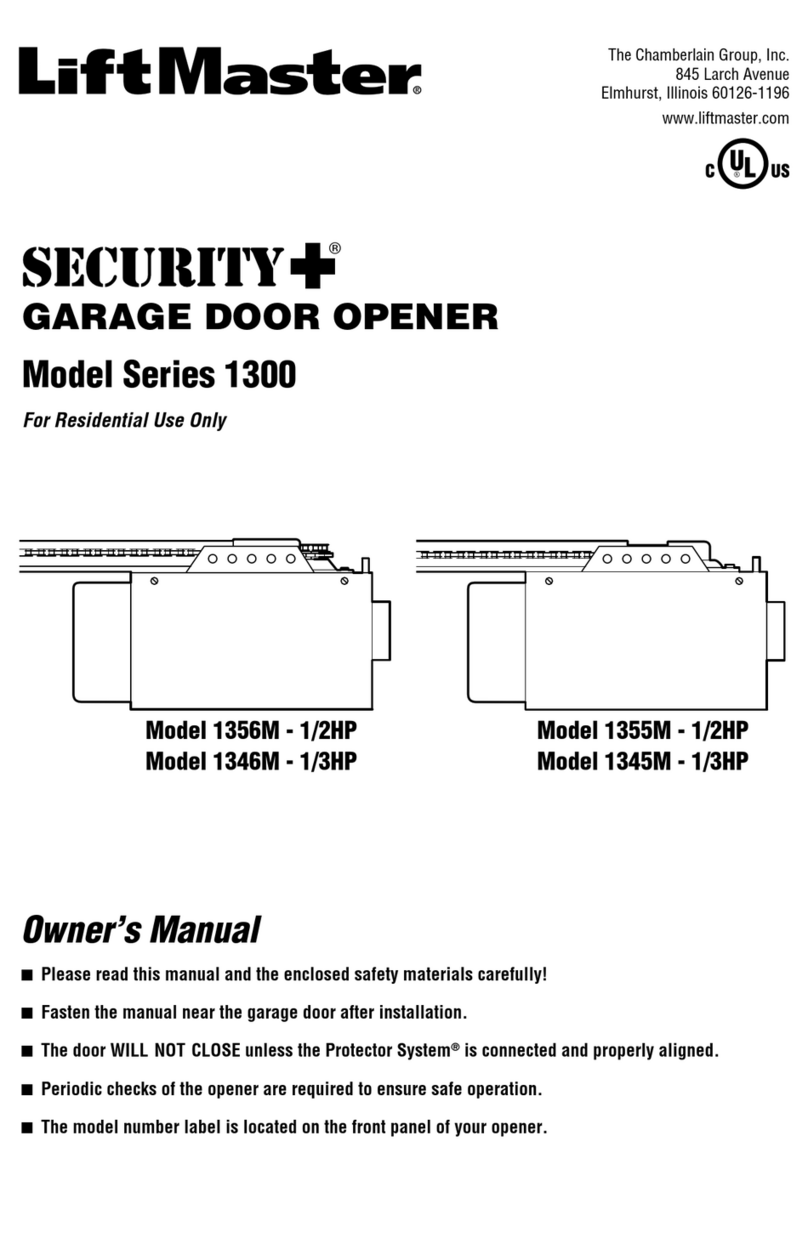
Chamberlain
Chamberlain 1356M owner's manual
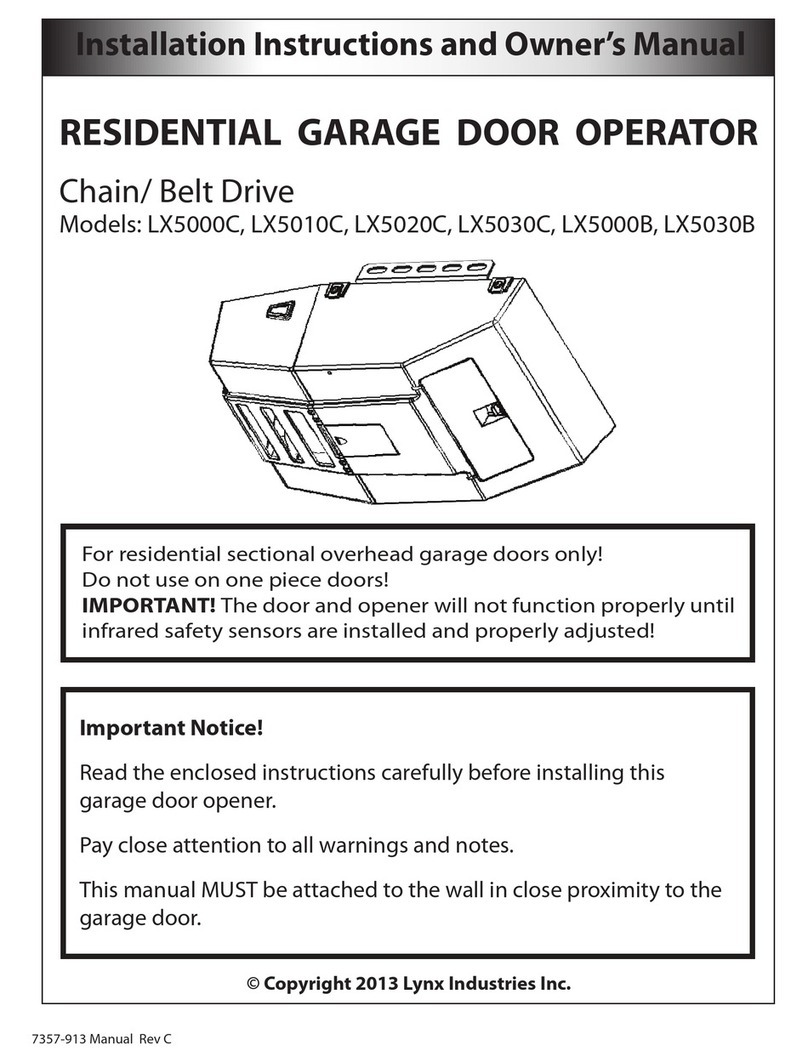
Lynx Industries
Lynx Industries LX5000C Installation instructions and owner's manual
